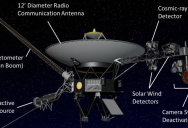NASA Engineers Activate Thrusters On Voyager 1 Spacecraft, Extending Its Mission Further Beyond Our Solar System

When it comes to exploring space, few things have done it better or longer than the Voyager 1 spacecraft, and it isn’t done yet. It first launched in September of 1977 with the goal of studying Jupiter, Saturn, and Saturn’s moon Titan before continuing on toward the edge of our solar system.
It has met and exceeded those goals, and continues to travel away from the Earth at around 17 km per second. It has long been the farthest man-made object in existence and continues to break that record every day. Currently, it is about 15.3 billion miles away.
Voyager 1 was never expected to last this long, and it has been running very low on fuel and power for years, but the engineers at NASA continue to coax life out of the incredible probe. When they found that the thrusters that it is currently using were getting clogged with silicon dioxide, they knew they had to make some adjustments.

This spacecraft has three thrusters, which are used to position the craft so that it can communicate with Earth. NASA engineers wanted to switch from the current thrusters to other ones that are not as clogged so that they can extend the mission even further.
Years ago, they were forced to shut down multiple systems on Voyager 1 to conserve power, and that included some of the heating systems. So, their first goal was to heat up the thrusters so that engaging them would not cause damage.
Next, they engaged the thrusters, which were confirmed to be successful in August.
Communicating with Voyager 1 is a lot more complicated than just telling it what to do. With the craft being so far away and radio signals traveling at the speed of light, it still takes just under 23 hours for the signal to arrive. Voyager 1 then needs to execute the commands and send the response back, which takes the same amount of time.
Needless to say, this is a time-consuming and stressful process for the Engineers at NASA.

This is just one more complicated task completed successfully for this incredible spacecraft. Voyager’s project manager, Suzanne Dodd, said in a statement:
“All the decisions we will have to make going forward are going to require a lot more analysis and caution than they once did.”
Voyager is not just traveling further away, it continues to transmit data that it has collected back to Earth. Scientists expect that the craft will stop doing this in 2025 due to dwindling power.
In addition, this craft carries the “Voyager Golden Record,” which has symbols that show the location of Earth relative to pulsars, and audio that has been engraved onto the disk similar to a record.
The audio has greetings in 55 different languages, 35 sounds from Earth including laughter, whale songs, and more. Also included were 90 minutes of Earth music, 115 images of life on Earth, and recorded greetings from President Jimmy Carter and UN Secretary-General Kurt Waldheim.
Let’s hope whatever finds that disk is friendly!
If you thought that was interesting, you might like to read about a second giant hole has opened up on the sun’s surface. Here’s what it means.

Sign up to get our BEST stories of the week straight to your inbox.




